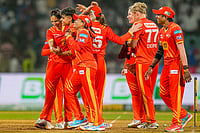Smriti* was not sure why she felt uncomfortable—the only thing that she could communicate was her uncle's touch was 'inappropriate'— different from those caring and affectionate touches that she was used to. As she complained to her mother, she was told not to share this with anyone. The 'uncle' however kept coming. Her mother sometimes saved her by saying that she was studying and at other times called her to the kitchen to help her with household chores. Eight-year-old Smriti is one of those thousands who regularly fall prey to predatory uncles and aunties and silently carry the trauma throughout their lives.
As we are today all set to celebrate 'Children's Day' with the distribution of toffees and sweets, special sports events, and cultural programs, we must look at those paedophile 'uncles' who will lure away his niece/nephew with a toffee to fulfill his perverse desire.
Safeguarding and protecting our children from predators alongside providing them with healthy and educated lives have been on the agenda of the world leaders for almost a century. On November 20, 1954, the foundation of World Children's Day was set up. On the same day in 1959, the UN general assembly adopted the Declaration of the Rights of the Child that in its preamble promised to give 'appropriate legal protection before as well as after birth'. Though it didn't define the age of the child for the probable controversies over abortions, it maintained non-discrimination, adequate nutrition, safety and the right to education as the bedrock of the children's rights' regime.
During this phase, India also used to observe November 20 as Children's day. However, only after the death of the first Prime Minister Jawaharlal Nehru in 1964 the Children's day was shifted to November 14 to commemorate the birth anniversary of 'Chacha Nehru' as he was lovingly called by the children.
Since then, Nehru's vision of a wealthy nation with healthy children has been in tatters. The latest data of the National Crime Records Bureau (NCRB) shows in 2021, 1,49,404 cases had been registered for crimes against children of which 53,874 or 36.05 per cent were filed under the Protection of Children from Sexual Offenses Act, commonly known as POCSO. While our children after their birth are deprived of basic care, education, and nutrition and are forced to engage in hard labor to mostly support the poor parents; our unborn children's fight against caste, religion, and gender prejudices starts from the womb.
The heinous gangrape of pregnant Bilkis Bano during the post-Godhra riots that accompanied with the killing of her three-year-old daughter didn't deter the people to garland the 11 convicts after their release on the ground of 'good behaviour'. The protection of the unborn child depends on their gender, religion, and caste location. The prevalence of female foeticide despite several hard legislative efforts could be gauged from the latest data published by Pew Research Center.
As per their reports that took into consideration the last three rounds of NFHS data; 9 million girls went missing due to infanticide between 2009-2019. Notably, in 1994 India banned prenatal sex determination through Pre-Conception and Pre-Natal Diagnostic Techniques Act.
The report also stunningly notes that female foeticide is more prevalent among Hindus than in any other religious community in India. “As India's largest religious group, Hindus make up 79.8 per cent of India's total population and account for a disproportionate share, 86.7%, of the missing female births,” reads the report. Interestingly, Muslims being the second largest religious community with 14% of the population have the lowest contribution to the number of 'missing girls'- approximately 6.6 per cent.
Whereas the lives of the unborn depend on their gender, religion and caste—those who managed to get detached from the umbilical cord start preparing to dodge impending abuses. The threats of abuse, if one thinks, come from the outsider, the 2007 Ministry of Women and Child Development on child sexual abuse gives a reality check.
The study conducted among a formidably large sample of 12, 447 children of different age groups, regions, language, castes and religion showed while every second child, almost 69 per cent of them face mundane emotional abuse, 53 per cent of them encounter some type of sexual abuse. Among them, half of the sexual crimes are committed by "persons known to the child or in a position of trust and responsibility," notes the report.
While the 'sweet home' is in several cases not so sweet for the children, various kinds of educational institutes where they spend the second most time of their days are not also safe. The researchers have shown that while the family accounts for 18-20 per cent of sexual abuse, the same for the institutions stands at 50 per cent. In this context, one must think what are the other factors that may have a correlation with child abuse.
D Carston, J Foster, and N Tripathi in their seminal paper Child Sexual Abuse in India: Current Issues and Research, published in Psychological Studies in 2013 showed through child abuse has a correlation to poverty, it is prevalent across the spectrum of classes and castes. However, as per their research, the factors that push up the chances of child abuse are an overcrowding, extended family living together, presence of numerous street children, and lack of recreational facilities in the families.
The poverty factor also comes along with another major component of abuse- 'neglect'. The World Health Organization's 1999 definition of child abuse also focuses on neglect. It defines child abuse as “all forms of physical and/or emotional ill-treatment, sexual abuse, neglect or negligent treatment or commercial or other exploitation, resulting in actual or potential harm to the child's health, survival, development or dignity in the context of a relationship of responsibility, trust or power."
Mohua Nigudkar and Neela Dabir in their EPW paper Child Abuse: Confronting Reality also note, “Neglect is the root cause of most cases of abuse. Neglect is seen at all levels – family, civil society, and the state. The neglect not only results in the abuse, it also accounts for the underreporting of the crimes."
However, the continuous efforts of child rights activists led to the passing of POCSO in 2012. Unlike the previous legislative mechanisms, POCSO criminalised a range of sexual activities and broadened the meaning of 'penetrative sexual assault' to include oral sex, and insertion of any object to mouth, anus or vagina besides the penile penetration. POCSO also makes it obligatory for the authorities like families or schools to report sexual violence immediately after they found it.
Despite these consecutive efforts, we are living in a time when parents, family members, teachers, and godmen are all engaged in some sort of violence against children. Apart from sexual abuse, the regular exploitation of more than 10 million children in the labor market, as per the data of Indian labour organisations, reflects the social pathology.
All of these together make us think about what we have done to our children. On this occasion of Children's day, it is the time to contemplate- Are our children happy enough to celebrate Children's Day?
(*Name changed to protect identity)



























